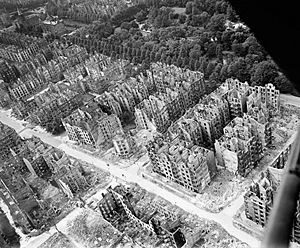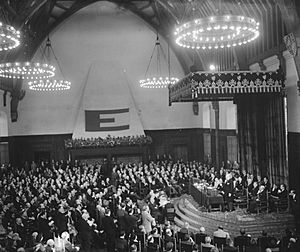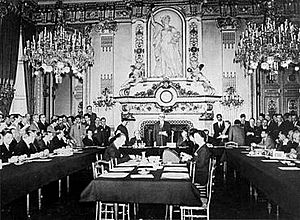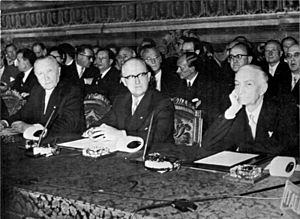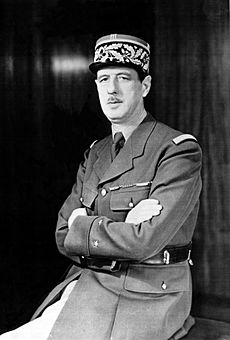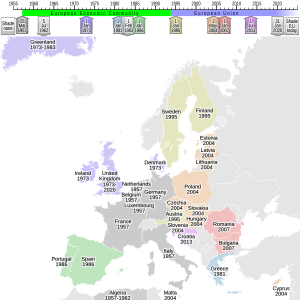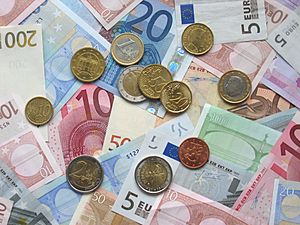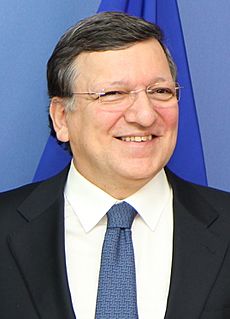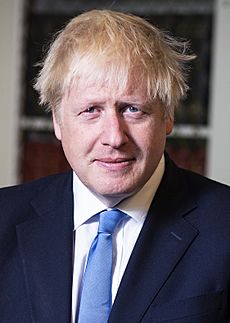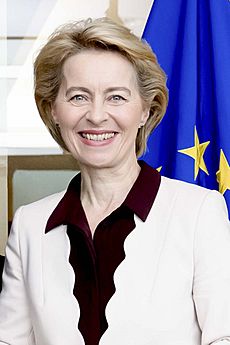History of the European Union facts for kids
The European Union (EU) is a group of countries in Europe that work together. It covers a large part of the European continent. The EU started with six countries and has grown to 27 member states. This means most countries in Europe are now part of it.
Since 1948, the idea behind the EU has been to "make war unthinkable." Leaders like Robert Schuman wanted to create a union so strong that countries would never fight each other again. They also wanted to make sure democracy grew among its members. This idea led to the European Coal and Steel Community (ECSC) in 1951. Later, the Treaty of Rome (1958) created the European Economic Community (EEC) and the European Atomic Energy Community (EAEC).
The Maastricht Treaty in 1992 officially created the European Union. This treaty also led to the creation of the single European money, called the euro, which started in 1999. The ECSC ended in 2002. Later treaties like Lisbon (2007) made the EU even stronger.
Contents
- Early Ideas of European Unity
- The First Steps (1948–1957)
- Three Communities and Growth (1958–1972)
- Expanding the Union (1973–1993)
- The European Union is Born (1993–2004)
- Big Expansion and New Challenges (2004–2007)
- Economic Challenges and Peace Prize (2008–2016)
- Brexit (2016–2020)
- Recent Events (2020–Present)
- Structural Evolution
- Images for kids
- See also
Early Ideas of European Unity
Europe has been seen as a special region for a very long time. Even in Ancient Greece, people thought of Europe as one of the three main landmasses.
Ancient Empires and Europe
Many empires controlled parts of Europe long ago. The Roman Empire was one of the first to control large parts of Southern and Western Europe. After the Roman Empire fell, other groups like the Frankish Empire and the Holy Roman Empire tried to unite parts of Europe again. They often used the idea of restoring the Roman Empire.
The Pope also played a big role in uniting European powers under a shared Christian identity. However, some countries like France and England later challenged this authority.
In the East, the Byzantine Empire (also called Eastern Rome) kept a strong presence in Eastern Europe. Later, the Ottoman Empire and the Russian Empire also claimed to be heirs to this Eastern Roman power, ruling over large areas of Europe.
Other groups in Europe, like the Greeks, Germans, Celts, and Slavs, also built their own kingdoms and empires. These were separate from the Roman and Byzantine influences.
Calls for Unity Before 1948
Before 1948, many people dreamed of a united Europe. Some, like Winston Churchill in 1946, even called for a "United States of Europe." These ideas often came from a desire for peace. They wanted to avoid the terrible wars that had happened in Europe.
Sometimes, countries united through royal families marrying each other. Less often, countries formed unions, like the Polish–Lithuanian Commonwealth.
In 1818, Tsar Alexander suggested a lasting European union. He even proposed having international armies to keep the peace.
During the 19th century, after the Napoleonic Wars, ideas of European unity grew stronger. Thinkers like Victor Hugo used the term "United States of Europe" in 1849. He imagined a future where European nations would be like a family.
From World War I to World War II
After World War I, people realized that European countries depended on each other for trade. They also saw how big the United States market was. This made them want to unite Europe economically. In the 1920s, economist John Maynard Keynes suggested a "Free Trade Union" in Europe.
Around the same time, Richard von Coudenhove-Kalergi started the Pan-Europa Movement. His ideas influenced leaders like Aristide Briand, who spoke in favor of a European Union in 1929.
World War II and Its Aftermath
World War II (1939-1945) showed the world the terrible effects of war, extremism, and genocide. People wanted to make sure such a war would never happen again. Many European countries lost their power, except for the Soviet Union, which became a superpower. This led to two main rival powers in the world.
After the war, the idea of countries working together became very popular. The United Nations was created in 1945. Many people saw European unity as a way to stop the extreme nationalism that had caused so much damage.
Even during the war, people like Altiero Spinelli called for European integration. In 1943, Winston Churchill spoke about creating a "Council of Europe" to bring nations together for peace.
After the war, in 1946, Churchill again called for a "United States of Europe." To prevent Germany from starting another war, its heavy industries were partly controlled by other countries.
The growing tension between the Western powers and the Soviet Union led to the start of the Cold War. This period, starting in 1948, marked the beginning of modern European integration.
The First Steps (1948–1957)
With the Cold War beginning, countries in Western Europe started forming alliances. The Treaty of Brussels in 1948 created the Western Union. The Organization for European Economic Co-operation was also set up to manage the Marshall Plan, which was money from the United States to help rebuild Europe.
A very important meeting was the Hague Congress in May 1948. This meeting led to the creation of the Council of Europe in 1949. The Council of Europe was the first group to bring Western European nations together. It helped create the European Convention on Human Rights in 1950.
The real start of the EU's institutions came on May 9, 1950, with the Schuman Declaration. Based on this speech, France, Italy, Belgium, the Netherlands, Luxembourg, and West Germany signed the Treaty of Paris (1951). This created the European Coal and Steel Community (ECSC) in 1951.
The leaders believed that if the coal and steel industries of these countries were linked, it would be much harder for them to go to war with each other. The ECSC helped Europe's economy grow and led to the creation of important EU bodies like the European Commission and the European Parliament.
The Marshall Plan from the United States greatly helped the ECSC. The U.S. gave billions of dollars to help rebuild Europe. This money helped feed people, rebuild industries, and provide energy. It also encouraged European countries to work together. Former German Chancellor Helmut Schmidt said that the EU's development was one of America's greatest achievements, thanks to the Marshall Plan.
After some failed attempts to create a European army and a political community, leaders met again. In 1957, they signed the Treaties of Rome. These treaties created the European Economic Community (EEC) and the European Atomic Energy Community (Euratom). These new communities focused on economic unity.
Three Communities and Growth (1958–1972)
The EEC worked to create a customs union among its members, meaning they would trade freely without tariffs. Euratom focused on nuclear energy. Even though they were separate, these communities shared the same courts and a common assembly.
In 1965, the three communities (ECSC, EEC, Euratom) were merged under one set of institutions. This created the European Communities on July 1, 1967.
During this time, important legal rules for European law were set. For example, the "direct effect" rule meant that European laws could be used by people in national courts. Another rule said that European law was more important than national law.
Expanding the Union (1973–1993)
After many talks, Denmark, Ireland, and the United Kingdom joined the European Communities on January 1, 1973. This was the first time the group expanded.
In 1979, people in Europe voted directly for members of the European Parliament for the first time. Simone Veil became the first female President of the European Parliament.
Greece joined in 1981. Then, Spain and Portugal joined in 1986. In 1982, Greenland voted to leave the Community.
In 1986, the European flag was adopted by the Communities. Leaders also signed the Single European Act, which helped complete the single market and gave the Community more power, especially in foreign policy.
A huge change happened in 1989 when the Berlin Wall fell. This event, along with other changes in Eastern Europe, opened the door for countries from the former Eastern Bloc to join the European Union.
With many new countries wanting to join, the Maastricht Treaty was signed on February 7, 1992. This treaty officially created the European Union when it came into force in 1993.
The European Union is Born (1993–2004)
On November 1, 1993, the Maastricht Treaty became active, creating the European Union. It included new areas like foreign policy and home affairs.
In 1994, Austria, Sweden, and Finland joined the EU. The Schengen Agreement also started, allowing people to travel between many member countries without passport checks.
The 1990s also saw the development of the euro. In 1999, the euro was launched as a currency. On January 1, 2002, euro notes and coins were put into use, replacing the old money in many countries.
During the 1990s, conflicts in the Balkans showed that the EU needed a stronger foreign policy. The EU struggled to react at first. This led to the Treaty of Amsterdam, which created the position of High Representative for foreign policy.
In 1999, there was a budget crisis, and the European Commission had to resign. This led to more challenges for the Commission in the following years.
The Nice Treaty was signed in 2001. It made the final preparations for the big enlargement in 2004, when 10 new countries joined the EU.
Big Expansion and New Challenges (2004–2007)
From June 10-13, 2004, the 25 member states held the largest international election ever. José Manuel Barroso became the new President of the European Commission.
A proposed constitution for Europe was signed in 2004. However, people in France and the Netherlands voted against it in referendums. So, the constitution was dropped. Instead, a new treaty, the Treaty of Lisbon, was signed in 2007 and came into force in 2009. This treaty created the role of President of the European Council and made the High Representative position stronger.
In 2007, Romania and Bulgaria joined the EU. Slovenia adopted the euro in 2007, followed by Malta and Cyprus in 2008, and Slovakia in 2009.
Economic Challenges and Peace Prize (2008–2016)
In 2008, the eurozone faced its first economic recession. Some countries like Greece, Ireland, and Portugal struggled with their finances. Eurozone leaders agreed to provide loans to help these countries. This led to discussions about closer economic cooperation.
The European Union received the 2012 Nobel Peace Prize in 2012. The Nobel Committee said the EU had helped bring "peace and reconciliation, democracy and human rights in Europe." They noted that war between Germany and France, once enemies, was now "unthinkable."
On July 1, 2013, Croatia joined the EU.
Brexit (2016–2020)
On June 23, 2016, the people of the United Kingdom voted to leave the European Union in a referendum. This event is known as Brexit. The UK officially left the EU on January 31, 2020. It was the first country to ever leave the EU.
Recent Events (2020–Present)
COVID-19 Pandemic Impact
After the economic problems caused by the COVID-19 pandemic, EU leaders agreed for the first time to borrow money together. This money was used to fund the European Recovery Program called Next Generation EU.
Russo-Ukrainian War Impact
On February 24, 2022, Russia launched a full-scale invasion of Ukraine. The European Union quickly put strong sanctions on Russia. It also agreed to send military aid to Ukraine.
Many Ukrainian refugees fled the conflict and were welcomed by neighboring EU countries. The war also showed how much the EU depended on Russia for energy. This made the EU want to switch to other energy sources and develop more clean energy.
Structural Evolution
Since the end of World War II, sovereign European countries have entered into treaties and thereby co-operated and harmonised policies (or pooled sovereignty) in an increasing number of areas, in the European integration project or the construction of Europe (French: la construction européenne). The following timeline outlines the legal inception of the European Union (EU)—the principal framework for this unification. The EU inherited many of its present responsibilities from the European Communities (EC), which were founded in the 1950s in the spirit of the Schuman Declaration.
| Legend: S: signing F: entry into force T: termination E: expiry de facto supersession Rel. w/ EC/EU framework: de facto inside outside |
[Cont.] | ||||||||||||||||
| (Pillar I) | |||||||||||||||||
| European Atomic Energy Community (EAEC or Euratom) | [Cont.] | ||||||||||||||||
| European Economic Community (EEC) | |||||||||||||||||
| Schengen Rules | European Community (EC) | ||||||||||||||||
| 'TREVI' | Justice and Home Affairs (JHA, pillar II) | ||||||||||||||||
| [Cont.] | Police and Judicial Co-operation in Criminal Matters (PJCC, pillar II) | ||||||||||||||||
Anglo-French alliance |
[Defence arm handed to NATO] | European Political Co-operation (EPC) | Common Foreign and Security Policy (CFSP, pillar III) |
||||||||||||||
| [Tasks defined following the WEU's 1984 reactivation handed to the EU] | |||||||||||||||||
| [Social, cultural tasks handed to CoE] | [Cont.] | ||||||||||||||||
Images for kids
See also
 In Spanish: Historia de la Unión Europea para niños
In Spanish: Historia de la Unión Europea para niños
- Timeline of European Union history
- Enlargement of the European Union
- History of the euro
- Founding fathers of the European Union
- History of Europe


